
Caravaggio and Apocalipse Now
The existential condition of the Nigredo is experienced by men and women who wish to transform their psychic impulses into pure sentiment, affection and self-knowledge.
Very often a difficulty in expressing sentiment stems from problematical relations with parents, siblings and from the emotional dimension of existence. Complexes rooted in an individual’s relationship with his or her father or mother may inhibit the natural flow of psychic energy, which may remain in an “undeveloped state”, and “fixed” at an early stage of growth.
The aim of the alchemist still struggling at the Nigredo stage is to transform the “rough stone” (the Pleroma) into Philosopher’s Mercury, which must be distilled until the Elixir of knowledge is obtained. In practical terms, the experience involves refining “psychic energy” generated by the primary instincts into “mental energy” to attain a stage at which the individual comprehends that human impulses constitute a creative potential which we have at our disposal and which can aid us in our search for happiness.
In the film Iris, a true story of the last years of an Irish writer, the protagonist intuitively understands that only the mind has the power to free an individual’s creative potential.
“Neither love nor education can ever make us happy. Books cannot teach us how to lead happy lives, however education can provide us with the instruments that will allow us recognise what work would be needed to attain such a goal.”
Education, training, control, the transmission of ideas, channelling and orientation are terms which have as their common denominator the intention of working with psychic energy; and, that is, the uncontrolled stream of emotions, words, actions and impulsive gestures that represent an instinctive reaction of the organism in the presence of an external stimulus or provocation.
Psychic energy manifests as fear, anger, ill feelings, envy, jealousy, hate, greed, attachment and its physical manifestations are tears, shouting, bilious attacks, stomach pains and secretions of the endocrine glands that change the colour of our skin or make our lips turn rigid. Psychic energy is in most cases a clear warning of the existence of a conflict that can have an internal influence on the body.
The conflictual dimension of sentiment has been widely analysed by Western psychology, which has identified in traditional myths, fables and legends the educational instruments with which societies of the past attempted, through metaphor, to educate the individual to become aware of and to control emotion.
“The highly developed human brain, with its capacity for coping with the unexpected and new concepts, and our protracted human infancy, much longer than that typical of other species, has endowed humanity with a learning capacity far superior to analogous capabilities in any other creatures. However, such advantages also imply the risk of disorientation. One of the principal aims of the common rituals of both primitive and the more highly developed races is thus that of guiding children in the developmental process leading to adulthood. The dependency of infants must be transformed into the responsibility of adults, and in the terms prescribed by our social order.
A son must become a father and a daughter a mother; each must pass from the infantile stage to adolescence, which are practically the same everywhere, and then become an adult and assume the various social roles.
Instincts must be governed and matured in the interest of both the group and the individual; and, traditionally, the first function of mythology was that of serving this social and psychological purpose. The individual adapts to his group and the group, in turn, to its environment, with a sense of gratitude for the miracle of life.
I would moreover suggest that this is the function of village mythology, whereby instincts are controlled and sentiment is duly oriented.”1
Education through myths, fables and legends is thus a determining factor in the transmission of the “energy” inherent in a conventional code of conduct of the group one belongs to. In a village community the experience of Individual Nigredo is in fact an exploration of the instincts in a controlled environment.
Negative emotions are subject to an ethical and moral order, within the framework of religious rules and civil law.
Every individual experiences the Nigredo in a manner determined by the social group in which the passage from adolescence to maturity occurs. A sense of “belonging” thus allows and induces the personality to adhere to models of behaviour which are functional for the aims and objectives of the community. Conventional education insists on repression and the conscious control of negative emotions as a means of inhibiting violent reactions.
In civilised countries children are taught to control both their actions and their emotions. In fact, many people become so good at hiding or disguising their instinctive reactions - not only with respect to others but also with respect to themselves - that extreme forms of self-control can make them vulnerable and susceptible to other dangers.
If inner barriers collapse - even minimally - owing to a lowering of the threshold of consciousness, or if a change in outer conditions removes certain inner restrictions, repressed emotion may then explode in an uncontrollable manner, and become doubly destructive, as the person in whom they become manifest has never been aware of their presence.
The Nigredo of the instincts is thus latent in every individual and can become quite manifest at certain moments during a lifetime: when exhaustion, depression, stress and, above all, frustration have the effect of triggering sexual and creative energies that have hitherto remained inert and imploded for so long.
The Nigredo of consciousness on the other hand has an “explosive” effect and can oppose social conventions or the moral codes of religion and social ethics. The alchemist however perceives that a “second truth” exists, which transcends any commitment to a “group”, whereby every achievement requires the “sacrifice” on the part of the single individual for the common good.
“This is just the expression of a fundamental norm that regulates social life in the entire animal kingdom. It appears moreover when the loss of personal gain - determined by submission to the rules of the group - is largely compensated for by gains that derive from the success of the group. A corollary of this dynamic, in the case of human beings, is that rich, self-centred groups which adhere to unhealthy religions and unworthy ideologies are contrasted by the poor, altruistic followers of new religious faiths.
The promise of a better, future life - whether it be an earthly paradise or resurrection in heaven - is a cultural reward that may justify the imperative of those forms of submission upon which society is based.
An experience relived again and again by each succeeding generation, submission to the group and its moral codes becomes stabilised in official doctrine and individual faith. And yet, it was never decreed by God, nor does it descend from heaven in the form of an undeniable truth. It merely evolves as an indispensable procedure useful for the survival of the social “organism”.”
The empirical alchemist however believes that “religious precepts and faith are entirely materialistic products of the mind.
For thousands of generations they have contributed towards our survival and the reproductive success of those who conform to tribal creeds.
Epigenetic rules and hereditary trends in mental development have had sufficient time to evolve and generate moral and religious sentiments. The possibility of indoctrinating has practically become an instinct.”
Aware of the rules of communication within the “global village” and a necessity for the “sharing” of mass culture, the gaze and attention of the alchemist - as was evident in the work of Caravaggio and Coppola - turns inwards, in search of a vital nucleus and the true riches of human nature concealed within the individual and an inexhaustible manifestation of emotional, creative and spiritual energies.
Historically, the philosophical interests of the alchemist-empiricist are certainly not recent developments, and their origins are rooted in Aristotle’s Nichomachean ethics.
Alchemical experience however undoubtedly occurred long before the earliest historical recordings, and can be said to have their origins in the sad action perpetrated by Cain. At a certain point, human beings perceived the fine thread which separates good from evil, and soon comprehended that the good of society does not necessarily correspond with the interests of the individual.
Modern film producers have often “stuck their fingers in the fresh wounds” of those who in recent times have had the task of taking up arms to defend the American way of life: a model of society in which the freedom of the individual is all too often measured in terms of economic standing and social status. In the name of the collective wellbeing of a nation, political, social, financial and national prestige and feelings of love for one’s homeland or family have functioned as a screen upon which illusions and falsehoods are easily projected.
Moral sentiments have a powerfully manipulative effect when the instinct to defend the group is experienced by the individual in terms of personal “conscience”, self-respect, remorse, compassion and sympathy, shame, humility and moral outrage.
The Nigredo “controlled” by civil and religious institutions promotes a “cultural evolution of the individual”, goading him on to assume schemes of behaviour which express the universal moral codes of honour, patriotism, altruism, justice, compassion, piety and redemption, all of which, in times of a crisis, are capable of creating a “scapegoat”.
Loyalty towards the group is thus crystallized by means of symbols and “sacred” goals, and the mythologies abound with epic tales of the victories of crusaders over their evil enemies.
The relationship between Willard (Martin Sheen) and Kurtz (Marlon Brando) - the two protagonists of the film Apocalypse Now - represents the point of culmination in the crisis between “experience and conscience” in Western culture, still bereft of the cognitive means of exploring the “Heart of Darkness” of the human psyche.
Very little progress has been in the psychological, ethical and biological exploration of moral sentiment, which derives great energy from the instincts.
The last two thousand years of collective Nigredo have produced so much horror and destruction as the control of our psychic energy is wielded by powers that subtly operate through the dissemination of collective codes in accordance with predetermined aims.
The collective conscience is stronger than any form of ethical and moral education, which can be overridden by the doctrines of religious sects and fanatics, by the clan that holds sway over a particular territory, by the political party that advocates models of development favourable only to the ruling classes or by models promoted by the conformism of the masses. The Western conscience remains poised between ethics founded on a moral rationalisation of customs (God), and on ethical codes founded on a technical rationalisation of impulses (Science) and social behaviour through repression (Laws).
The point of view of the alchemist is based on the principle that purification and the abandonment of unconscious behaviour induced by group codes may occur through the process of transforming libido into love, creativity and a knowledge of human nature.
Such knowledge is closely linked to the study of psychic impulses and the material functioning of the brain.
There is moreover a deep void in our knowledge, which for the moment hinders the study (also from the biological point of view) of a fundamental branch of ethics: moral sentiment.
Moral sentiment is the crucial point of convergence of all hopes for a positive transformation of society and every single individual.
Moral sentiment draws directly from the dimension of human instinct, which provides the raw material that has to be “cooked” very slowly, so that the psychic energy and libido are not dispersed and can be transformed into love, friendship and the spirit of collaboration.
The Nigredo, as conceived by Renaissance alchemists, is an empirical procedure that draws psychic energy into a “vas hermeticum” located inside the athanor, a metaphor for the psychic body. Here, the energy is then “elaborated” by means of the imagination, and transformed into mental desire, a creative will and, finally, a “solar consciousness”.
In our own day and age, the “vas hermeticum” is formed by our modern schools and colleges, where adolescents are educated. Our schools teach the “mythology of the village”, while literature, films and art are provided to transmit the “mythology of the forest”, which can lead to inner soul-seeking and the possible transformation of the creative impulses into pure conscience.
The mythology of the forest is gradually disappearing however, and the myths of the past are at risk. Formerly, for generations, the community adhered to such rigid behaviour that a divinity could last for thousands of years.
Nowadays, the rules are “fluid”, and whether we like it or not, we are left to tend for ourselves; in our inner dimension, in forests with no well-defined routes, we may venture and delve into our books, metropolitan legends and the images and icons of modern life to discover but faint traces of a long-lost Grail.
For this purpose, moreover, the myths that should guide us no longer provide any ethical norms. No longer passed on by each generation, they are out of date and out of place; they are being swept away by the heroes of the cinema, by comics and video games. In our modern era, there is no horizon and no mythogenetic zone. Only the cinema now seems to possess the power to interpret the reality of the individual, the collective unconscious and forge new myths, around which the desires of the androgynous soul converge to discover hidden truths.
Nevertheless, by filtering the experiences of characters in modern films with the knowledge of Renaissance artists, it is still possible to rediscover a logical link between the heart, the eyes and the brain as it may be experienced by contemporary film producers.
The film Apocalypse Now, for example, is a foundation stone, which would allow us to “cook” the raw material of the instincts; and equally fundamental is the stone upon which is set Caravaggio’s scene of the Deposition of the Body of Christ. Both works reveal the symbolic body of Christ, or the monstrous consequences generated by human folly, our collective libido and ego-manic individualism suffered by the frail body of both the individual and collective soul.
Like Caravaggio, Kurtz provides us with an extreme form of ritual, which the energy of the psyche needs to greatly expand the powers of the mind.
Like a shaman, he channels the energy of blood and adrenalin towards a conscious descent into the hell of the psyche, where the instinctive self holds sway over everything. This “pleroma” of the instincts or “heart of darkness” is manoeuvred in an occult manner through a series of chemical responses; and these are triggered in the blood of the observer by the perceived tension, stress, repressed anger, fear of death and by the instinct for survival conveyed in the images of the film.
The profound stirring of the psyche, horror, fear, blood, rituals and symbols are the alchemical ingredients that withstand any resistance opposed by a “moral” conscience induced in the soldiers by their military training, or their political or ideological backgrounds.
And they are free to manifest their Nigredo, as a “biological world” is revealed in the sequence of such crude images. The survival instinct is triggered in obscure parts of our central nervous system, in the oldest parts of the brain, and by substances secreted by numerous glands and the stimuli of adrenalin. Nervous responses to environmental stimuli are linked also with endorphins to produce even a state of pleasure in performing - and in depicting - such bloody acts.
The creative alchemy of Caravaggio is capable of stimulating the release of adrenalin, and directs the attention of the observer of his art towards the expressions and plight of his protagonists, thereby generating virtual emotions, psychic impulses and states of mind.
Coppola’s alchemy consists in contrasting the solar rationality of Willard with the lunar folly of Kurtz. Going back along the river to look for Kurtz, at a certain point Coppola decides to let us see Willard’s head appear out of the water, in a setting influenced and created by a totally unnatural light. In one hand he is holding a mitre, and in the other a book.
As occurs in Caravaggio’s work, Willard reveals the presence of two important allies capable of helping him on his way towards the final realisation of his mission: towards the conclusion of his Nigredo of Consciousness in the deep core of the “Heart of Darkness”.
Courage and knowledge are required to hold back the transfer of irrational psychic energy into those parts of the brain in which “emotional logic” and moral sentiment are skilfully manipulated by information system or a Kurtz of the moment.
Courage and knowledge are the only arms Western consciousness can adopt to firmly contrast the development of terrorism induced by Islamic extremism in cities that symbolise Western culture.
History seems to repeat itself in symbolic form, and Willard too uses symbolic gestures.
When he eventually kills Kurtz, the journey within the psyche has extended beyond the final barrier. The “father” who had been held in increasing esteem since his having been nominated as a target for termination (as he drew closer and closer to the monster’s lair, Willard had even begun to see Kurtz as a mythical figure) is finally destroyed. Now he knows. He knows that beyond reason there is madness and a pure pleasure instinct.
The film also acquires knowledge. As in the initiation of Don Juan by Castaneda, Willard-Kurtz-Coppola understands that after defeating fear and subjecting the power induced by horror, blood and disdain for life, he has to deal with wisdom itself. And he must do so with a lucidity which is in itself a “spiritual” experience, full of hope for mankind and faith in the power of the “Universal Self” (symbolised by the alchemists as Hermes/Filius Noster) to induce through conflictual means a recognition of one’s errors and the experience of opposing forces (mankind and reason, love and peace).
Like Willard, Hermes emerges from the river, holding the caducee: the symbol of an all-embracing mind. In the other hand he holds not a mitre but an orb surmounted by the cross, the symbol of knowledge and experience of transcendent faculties that emerge within every individual (regardless of race or religion) when the “Heart of Darkness”, which conceals the mystery of death and the alchemical transformation of opposites, has been fully explored.
It is not necessary to take up arms to restore order and justice, but to project the light of critical understanding above the ruins and symbols generated by Western knowledge.
Caravaggio was an instinctive precursor of this method.
His works stimulate disturbing emotions and, even now, after hundreds of years, they are still capable of kindling the fire of reflection in the mind of an observer.
The existential condition of the Nigredo is experienced by men and women who wish to transform their psychic impulses into pure sentiment, affection and self-knowledge.
Very often a difficulty in expressing sentiment stems from problematical relations with parents, siblings and from the emotional dimension of existence. Complexes rooted in an individual’s relationship with his or her father or mother may inhibit the natural flow of psychic energy, which may remain in an “undeveloped state”, and “fixed” at an early stage of growth.
The aim of the alchemist still struggling at the Nigredo stage is to transform the “rough stone” (the Pleroma) into Philosopher’s Mercury, which must be distilled until the Elixir of knowledge is obtained. In practical terms, the experience involves refining “psychic energy” generated by the primary instincts into “mental energy” to attain a stage at which the individual comprehends that human impulses constitute a creative potential which we have at our disposal and which can aid us in our search for happiness.
In the film Iris, a true story of the last years of an Irish writer, the protagonist intuitively understands that only the mind has the power to free an individual’s creative potential.
“Neither love nor education can ever make us happy. Books cannot teach us how to lead happy lives, however education can provide us with the instruments that will allow us recognise what work would be needed to attain such a goal.”
Education, training, control, the transmission of ideas, channelling and orientation are terms which have as their common denominator the intention of working with psychic energy; and, that is, the uncontrolled stream of emotions, words, actions and impulsive gestures that represent an instinctive reaction of the organism in the presence of an external stimulus or provocation.
Psychic energy manifests as fear, anger, ill feelings, envy, jealousy, hate, greed, attachment and its physical manifestations are tears, shouting, bilious attacks, stomach pains and secretions of the endocrine glands that change the colour of our skin or make our lips turn rigid. Psychic energy is in most cases a clear warning of the existence of a conflict that can have an internal influence on the body.
The conflictual dimension of sentiment has been widely analysed by Western psychology, which has identified in traditional myths, fables and legends the educational instruments with which societies of the past attempted, through metaphor, to educate the individual to become aware of and to control emotion.
“The highly developed human brain, with its capacity for coping with the unexpected and new concepts, and our protracted human infancy, much longer than that typical of other species, has endowed humanity with a learning capacity far superior to analogous capabilities in any other creatures. However, such advantages also imply the risk of disorientation. One of the principal aims of the common rituals of both primitive and the more highly developed races is thus that of guiding children in the developmental process leading to adulthood. The dependency of infants must be transformed into the responsibility of adults, and in the terms prescribed by our social order.
A son must become a father and a daughter a mother; each must pass from the infantile stage to adolescence, which are practically the same everywhere, and then become an adult and assume the various social roles.
Instincts must be governed and matured in the interest of both the group and the individual; and, traditionally, the first function of mythology was that of serving this social and psychological purpose. The individual adapts to his group and the group, in turn, to its environment, with a sense of gratitude for the miracle of life.
I would moreover suggest that this is the function of village mythology, whereby instincts are controlled and sentiment is duly oriented.”1
Education through myths, fables and legends is thus a determining factor in the transmission of the “energy” inherent in a conventional code of conduct of the group one belongs to. In a village community the experience of Individual Nigredo is in fact an exploration of the instincts in a controlled environment.
Negative emotions are subject to an ethical and moral order, within the framework of religious rules and civil law.
Every individual experiences the Nigredo in a manner determined by the social group in which the passage from adolescence to maturity occurs. A sense of “belonging” thus allows and induces the personality to adhere to models of behaviour which are functional for the aims and objectives of the community. Conventional education insists on repression and the conscious control of negative emotions as a means of inhibiting violent reactions.
In civilised countries children are taught to control both their actions and their emotions. In fact, many people become so good at hiding or disguising their instinctive reactions - not only with respect to others but also with respect to themselves - that extreme forms of self-control can make them vulnerable and susceptible to other dangers.
If inner barriers collapse - even minimally - owing to a lowering of the threshold of consciousness, or if a change in outer conditions removes certain inner restrictions, repressed emotion may then explode in an uncontrollable manner, and become doubly destructive, as the person in whom they become manifest has never been aware of their presence.
The Nigredo of the instincts is thus latent in every individual and can become quite manifest at certain moments during a lifetime: when exhaustion, depression, stress and, above all, frustration have the effect of triggering sexual and creative energies that have hitherto remained inert and imploded for so long.
The Nigredo of consciousness on the other hand has an “explosive” effect and can oppose social conventions or the moral codes of religion and social ethics. The alchemist however perceives that a “second truth” exists, which transcends any commitment to a “group”, whereby every achievement requires the “sacrifice” on the part of the single individual for the common good.
“This is just the expression of a fundamental norm that regulates social life in the entire animal kingdom. It appears moreover when the loss of personal gain - determined by submission to the rules of the group - is largely compensated for by gains that derive from the success of the group. A corollary of this dynamic, in the case of human beings, is that rich, self-centred groups which adhere to unhealthy religions and unworthy ideologies are contrasted by the poor, altruistic followers of new religious faiths.
The promise of a better, future life - whether it be an earthly paradise or resurrection in heaven - is a cultural reward that may justify the imperative of those forms of submission upon which society is based.
An experience relived again and again by each succeeding generation, submission to the group and its moral codes becomes stabilised in official doctrine and individual faith. And yet, it was never decreed by God, nor does it descend from heaven in the form of an undeniable truth. It merely evolves as an indispensable procedure useful for the survival of the social “organism”.”
The empirical alchemist however believes that “religious precepts and faith are entirely materialistic products of the mind.
For thousands of generations they have contributed towards our survival and the reproductive success of those who conform to tribal creeds.
Epigenetic rules and hereditary trends in mental development have had sufficient time to evolve and generate moral and religious sentiments. The possibility of indoctrinating has practically become an instinct.”
Aware of the rules of communication within the “global village” and a necessity for the “sharing” of mass culture, the gaze and attention of the alchemist - as was evident in the work of Caravaggio and Coppola - turns inwards, in search of a vital nucleus and the true riches of human nature concealed within the individual and an inexhaustible manifestation of emotional, creative and spiritual energies.
Historically, the philosophical interests of the alchemist-empiricist are certainly not recent developments, and their origins are rooted in Aristotle’s Nichomachean ethics.
Alchemical experience however undoubtedly occurred long before the earliest historical recordings, and can be said to have their origins in the sad action perpetrated by Cain. At a certain point, human beings perceived the fine thread which separates good from evil, and soon comprehended that the good of society does not necessarily correspond with the interests of the individual.
Modern film producers have often “stuck their fingers in the fresh wounds” of those who in recent times have had the task of taking up arms to defend the American way of life: a model of society in which the freedom of the individual is all too often measured in terms of economic standing and social status. In the name of the collective wellbeing of a nation, political, social, financial and national prestige and feelings of love for one’s homeland or family have functioned as a screen upon which illusions and falsehoods are easily projected.
Moral sentiments have a powerfully manipulative effect when the instinct to defend the group is experienced by the individual in terms of personal “conscience”, self-respect, remorse, compassion and sympathy, shame, humility and moral outrage.
The Nigredo “controlled” by civil and religious institutions promotes a “cultural evolution of the individual”, goading him on to assume schemes of behaviour which express the universal moral codes of honour, patriotism, altruism, justice, compassion, piety and redemption, all of which, in times of a crisis, are capable of creating a “scapegoat”.
Loyalty towards the group is thus crystallized by means of symbols and “sacred” goals, and the mythologies abound with epic tales of the victories of crusaders over their evil enemies.
The relationship between Willard (Martin Sheen) and Kurtz (Marlon Brando) - the two protagonists of the film Apocalypse Now - represents the point of culmination in the crisis between “experience and conscience” in Western culture, still bereft of the cognitive means of exploring the “Heart of Darkness” of the human psyche.
Very little progress has been in the psychological, ethical and biological exploration of moral sentiment, which derives great energy from the instincts.
The last two thousand years of collective Nigredo have produced so much horror and destruction as the control of our psychic energy is wielded by powers that subtly operate through the dissemination of collective codes in accordance with predetermined aims.
The collective conscience is stronger than any form of ethical and moral education, which can be overridden by the doctrines of religious sects and fanatics, by the clan that holds sway over a particular territory, by the political party that advocates models of development favourable only to the ruling classes or by models promoted by the conformism of the masses. The Western conscience remains poised between ethics founded on a moral rationalisation of customs (God), and on ethical codes founded on a technical rationalisation of impulses (Science) and social behaviour through repression (Laws).
The point of view of the alchemist is based on the principle that purification and the abandonment of unconscious behaviour induced by group codes may occur through the process of transforming libido into love, creativity and a knowledge of human nature.
Such knowledge is closely linked to the study of psychic impulses and the material functioning of the brain.
There is moreover a deep void in our knowledge, which for the moment hinders the study (also from the biological point of view) of a fundamental branch of ethics: moral sentiment.
Moral sentiment is the crucial point of convergence of all hopes for a positive transformation of society and every single individual.
Moral sentiment draws directly from the dimension of human instinct, which provides the raw material that has to be “cooked” very slowly, so that the psychic energy and libido are not dispersed and can be transformed into love, friendship and the spirit of collaboration.
The Nigredo, as conceived by Renaissance alchemists, is an empirical procedure that draws psychic energy into a “vas hermeticum” located inside the athanor, a metaphor for the psychic body. Here, the energy is then “elaborated” by means of the imagination, and transformed into mental desire, a creative will and, finally, a “solar consciousness”.
In our own day and age, the “vas hermeticum” is formed by our modern schools and colleges, where adolescents are educated. Our schools teach the “mythology of the village”, while literature, films and art are provided to transmit the “mythology of the forest”, which can lead to inner soul-seeking and the possible transformation of the creative impulses into pure conscience.
The mythology of the forest is gradually disappearing however, and the myths of the past are at risk. Formerly, for generations, the community adhered to such rigid behaviour that a divinity could last for thousands of years.
Nowadays, the rules are “fluid”, and whether we like it or not, we are left to tend for ourselves; in our inner dimension, in forests with no well-defined routes, we may venture and delve into our books, metropolitan legends and the images and icons of modern life to discover but faint traces of a long-lost Grail.
For this purpose, moreover, the myths that should guide us no longer provide any ethical norms. No longer passed on by each generation, they are out of date and out of place; they are being swept away by the heroes of the cinema, by comics and video games. In our modern era, there is no horizon and no mythogenetic zone. Only the cinema now seems to possess the power to interpret the reality of the individual, the collective unconscious and forge new myths, around which the desires of the androgynous soul converge to discover hidden truths.
Nevertheless, by filtering the experiences of characters in modern films with the knowledge of Renaissance artists, it is still possible to rediscover a logical link between the heart, the eyes and the brain as it may be experienced by contemporary film producers.
The film Apocalypse Now, for example, is a foundation stone, which would allow us to “cook” the raw material of the instincts; and equally fundamental is the stone upon which is set Caravaggio’s scene of the Deposition of the Body of Christ. Both works reveal the symbolic body of Christ, or the monstrous consequences generated by human folly, our collective libido and ego-manic individualism suffered by the frail body of both the individual and collective soul.
Like Caravaggio, Kurtz provides us with an extreme form of ritual, which the energy of the psyche needs to greatly expand the powers of the mind.
Like a shaman, he channels the energy of blood and adrenalin towards a conscious descent into the hell of the psyche, where the instinctive self holds sway over everything. This “pleroma” of the instincts or “heart of darkness” is manoeuvred in an occult manner through a series of chemical responses; and these are triggered in the blood of the observer by the perceived tension, stress, repressed anger, fear of death and by the instinct for survival conveyed in the images of the film.
The profound stirring of the psyche, horror, fear, blood, rituals and symbols are the alchemical ingredients that withstand any resistance opposed by a “moral” conscience induced in the soldiers by their military training, or their political or ideological backgrounds.
And they are free to manifest their Nigredo, as a “biological world” is revealed in the sequence of such crude images. The survival instinct is triggered in obscure parts of our central nervous system, in the oldest parts of the brain, and by substances secreted by numerous glands and the stimuli of adrenalin. Nervous responses to environmental stimuli are linked also with endorphins to produce even a state of pleasure in performing - and in depicting - such bloody acts.
The creative alchemy of Caravaggio is capable of stimulating the release of adrenalin, and directs the attention of the observer of his art towards the expressions and plight of his protagonists, thereby generating virtual emotions, psychic impulses and states of mind.
Coppola’s alchemy consists in contrasting the solar rationality of Willard with the lunar folly of Kurtz. Going back along the river to look for Kurtz, at a certain point Coppola decides to let us see Willard’s head appear out of the water, in a setting influenced and created by a totally unnatural light. In one hand he is holding a mitre, and in the other a book.
As occurs in Caravaggio’s work, Willard reveals the presence of two important allies capable of helping him on his way towards the final realisation of his mission: towards the conclusion of his Nigredo of Consciousness in the deep core of the “Heart of Darkness”.
Courage and knowledge are required to hold back the transfer of irrational psychic energy into those parts of the brain in which “emotional logic” and moral sentiment are skilfully manipulated by information system or a Kurtz of the moment.
Courage and knowledge are the only arms Western consciousness can adopt to firmly contrast the development of terrorism induced by Islamic extremism in cities that symbolise Western culture.
History seems to repeat itself in symbolic form, and Willard too uses symbolic gestures.
When he eventually kills Kurtz, the journey within the psyche has extended beyond the final barrier. The “father” who had been held in increasing esteem since his having been nominated as a target for termination (as he drew closer and closer to the monster’s lair, Willard had even begun to see Kurtz as a mythical figure) is finally destroyed. Now he knows. He knows that beyond reason there is madness and a pure pleasure instinct.
The film also acquires knowledge. As in the initiation of Don Juan by Castaneda, Willard-Kurtz-Coppola understands that after defeating fear and subjecting the power induced by horror, blood and disdain for life, he has to deal with wisdom itself. And he must do so with a lucidity which is in itself a “spiritual” experience, full of hope for mankind and faith in the power of the “Universal Self” (symbolised by the alchemists as Hermes/Filius Noster) to induce through conflictual means a recognition of one’s errors and the experience of opposing forces (mankind and reason, love and peace).
Like Willard, Hermes emerges from the river, holding the caducee: the symbol of an all-embracing mind. In the other hand he holds not a mitre but an orb surmounted by the cross, the symbol of knowledge and experience of transcendent faculties that emerge within every individual (regardless of race or religion) when the “Heart of Darkness”, which conceals the mystery of death and the alchemical transformation of opposites, has been fully explored.
It is not necessary to take up arms to restore order and justice, but to project the light of critical understanding above the ruins and symbols generated by Western knowledge.
Caravaggio was an instinctive precursor of this method.
His works stimulate disturbing emotions and, even now, after hundreds of years, they are still capable of kindling the fire of reflection in the mind of an observer.
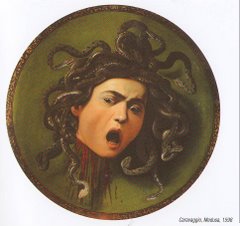
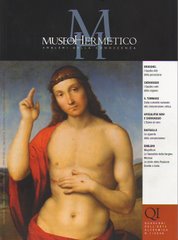

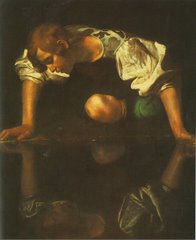
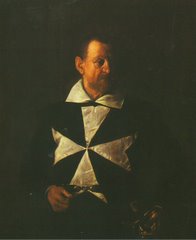
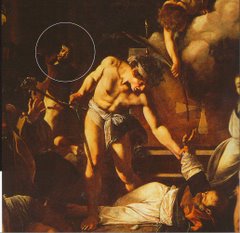
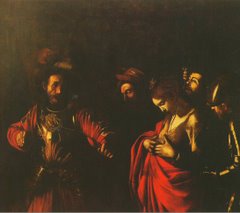



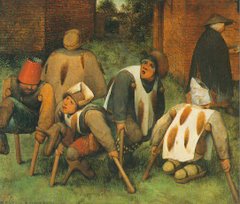
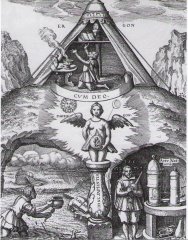


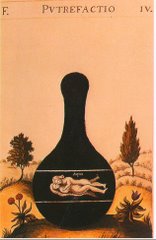

Nessun commento:
Posta un commento